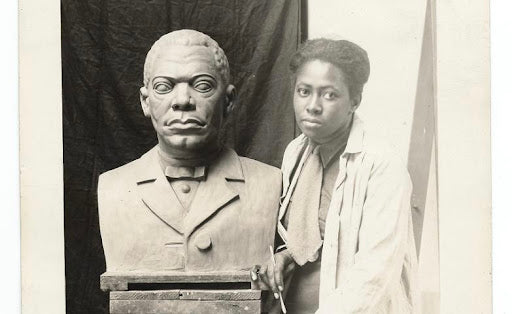More hidden history!
Selma Hortense Burke was born on December 31, 1900 in Mooresville, North Carolina, the seventh of 10 children born to Mary Jackson and Neal Burke. She found her passion for art at a young age, parlaying that into a successful career as an internationally renowned sculptor. Burke made a name for herself during Harlem’s renaissance era, and all of her hard work eventually led to her getting the opportunity to create a bronze relief portrait of President Franklin D. Roosevelt, which would be cemented in history as a part of our American currency.
Burke considered herself “a people’s sculptor” and hoped to use her work to speak to people all across the world, even those uninterested in art. She was known for her brass, bronze, alabaster, and limestone sculptures that focused on the human body. In addition to President Roosevelt, Burke also commissioned busts and figures for prominent African-American influencers like John Brown, Duke Ellington, Mary McLeod Bethune, and A. Philip Randolph.
Some of Burke’s most known work includes Torso (1937), Temptation (1938), (Untitled) Woman and Child (1950), and Together (1975). Her final sculpture was completed in 1980, a nine-foot bronze statue of Dr. Martin Luther King Jr. that is housed in Marshall Park in Charlotte, North Carolina. President Jimmy Carter awarded Burke with a Women’s Caucus for Art Lifetime Achievement award in 1979. She also received honorary doctorates from Livingstone College in 1970 and Spelman College in 1988. Today, Burke’s sculptures are still on display at various institutions, including Winston-Salem State University, the Smithsonian American Art Museum, and in her hometown at the Mooresville Public Library. Burke passed away in 1995, but her work is alive and well. To make sure we preserve her story and legacy, here are 5 important things you should know about Selma Burke, the sculptor behind the dime design, courtesy of the National Women’s History Museum:
Burke drew her inspiration for art from African artifacts.
As a young girl, Burke would often sculpt small objects and animals out of the white clay she found near a riverbed.
“One day, I was mixing the clay and I saw the imprint of my hands. I found that I could make something…something that I alone had created,” she told the New York Post in 1945.
Her father encouraged her to keep up with her art, and she would use things he brought back from his travels as models for her sculptures. After the family inherited a collection of African artifacts from Burke’s uncles who were missionaries, it cemented her interest in African art in particular.
She was an HBCU graduate.
As a budding artist, Burke was doing well, but her mother encouraged her to have a plan B and get into a career as a nurse. She listened and earned a degree from the Slater Industrial and Slater Normal School, now Winston-Salem State University, before attending Saint Agnes Training School for Nurses and graduating as a registered nurse in 1924.
Burke was molded in the Harlem Renaissance.
After school, she moved to New York during the 1920s, landing a job as a private nurse for Amelia Waring, heiress of the Otis Elevator empire. It was Waring who helped Burke gain exposure for her art in New York, and Burke became steeped in the Harlem Renaissance. She went on to study at Sarah Lawrence College, working as a model to pay for school. From New York, she traveled to Paris and Europe, studying under artists like Henri Matisse and Aristide Maillol.
She was a devout teacher.
After the rise of Nazis in Europe, Burke returned to New York City where she taught art to youth through the Progress Administration’s Federal Art Project and the Harlem Community Arts Center. In 1940, she opened the Selma Burke School of Sculpture, and the next year she earned her master’s from Columbia and held her first solo exhibit in New York. She would continue teaching throughout her career, eventually moving to Pennsylvania and running the Selma Burke Art Center in Pittsburgh from 1968-1981.
It was her portrait of President Roosevelt that inspired the dime design.
During World War II, Burke enlisted in the Navy as one of the first Black women to sign up. However, she injured herself while driving a truck and while recuperating, she won a national contest to commission a bronze relief portrait of President Franklin Roosevelt. Burke agreed to do the job but felt that pictures of the President wouldn’t suffice; she requested a sit-down meeting with him so she could draw her own sketch. Roosevelt agreed and during a two-day period in February 1944, Burke sketched him. He passed away less than a year later in April 1945.
On September 24, 1945, Roosevelt’s successor, President Harry S. Truman, unveiled the relief portrait done by Burke, and it became the inspiration for the image that was later commissioned on the U.S. dime. While the dime image’s credit is officially listed to U.S. Mint Chief Engraver John Sinnock, many agreed over the years that it was Burke’s depiction that Sinnock used.
Because of Selma Burke, we can!
5 important things you should know about Selma Burke, the sculptor behind the dime design. Burke seated next to her sculpture of Booker T. Washington, circa 1930. Photo Courtesy of the Archives of American Art/Smithsonian Institution

